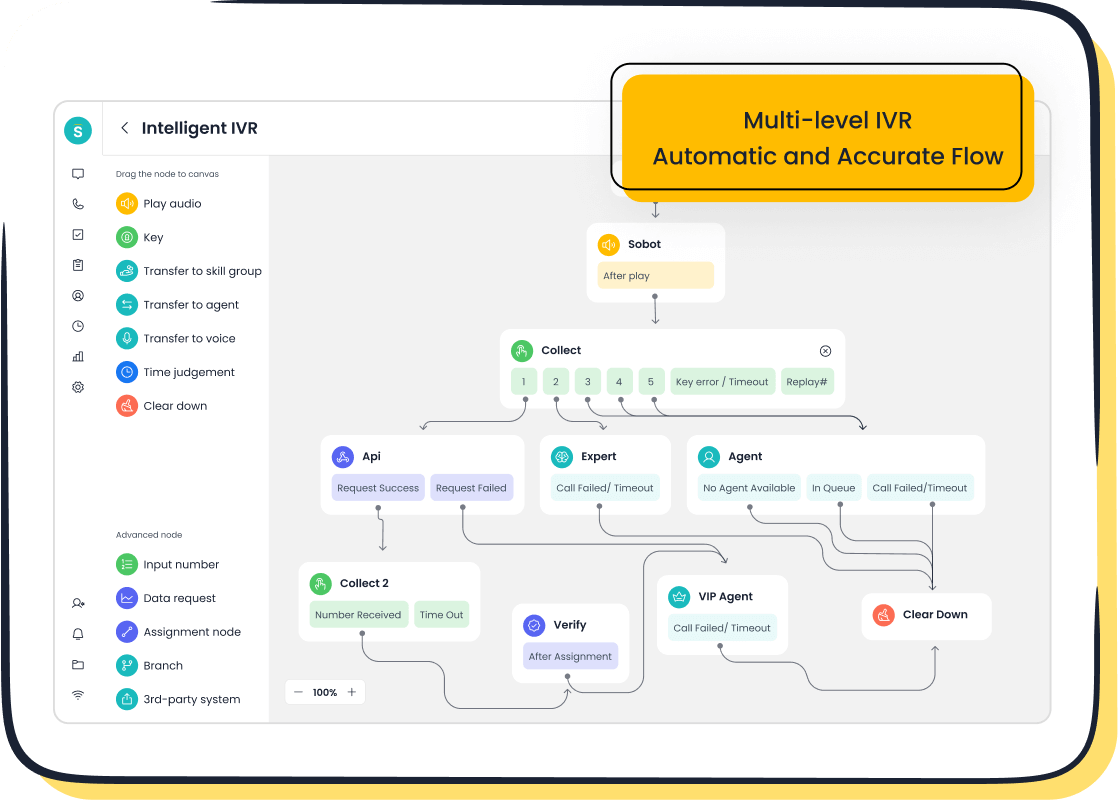Why Every Business Needs Multichannel Customer Service

You need multichannel customer service to keep up with today’s customer expectations. Customers want fast, easy help on the channels they use every day. See the data below:
| Customer Expectation Metric | Percentage |
|---|---|
| Customers wanting multichannel engagement | 62% |
| Customers preferring multichannel marketing | 72% |
| Customers expecting consistent interactions across channels | 90% |
A business that uses Sobot and Sobot AI gains smoother customer interactions and higher satisfaction. With the Sobot call center, you offer support where your customers need it most.
Multichannel Customer Service Overview

What Is Multichannel Customer Service?
You interact with brands in many ways today. Multichannel customer service means you can reach a business through several different channels, such as phone, email, live chat, or social media. According to Richpanel, multichannel customer service is a channel-centric approach. Each channel works on its own, so you might get different experiences depending on how you contact support. Businesses use this method to meet you where you are, but sometimes you have to repeat your information if you switch channels. This approach helps companies connect with more customers, but it can lead to inconsistent service if the channels do not share information.
Common Channels
You have many options to contact a business. Companies use multi-channel customer service to offer support on the platforms you prefer. Here is a table showing the most common channels and how people use them:
| Communication Channel | Customer Preference / Usage | Best Use Cases / Features |
|---|---|---|
| Live Chat | Real-time help on websites or apps | Quick questions, order tracking |
| SMS | 98% open rate; 61% want two-way texting | Fast, mobile communication |
| Phone | Popular for direct talk | Complex issues, urgent help |
| Used for detailed responses | Attachments, longer messages | |
| Social Media | Used by over 60% of consumers | Quick answers, public feedback |
| Self-service | Preferred by 67% for solving problems alone | FAQs, chatbots, 24/7 help |
| Forums | Customer-driven support | Peer advice, community help |
| Web Contact Forms | Structured inquiry submission | General questions, tracking |
| Video Chat | Useful for demos and troubleshooting | Visual support, complex issues |
You see multi-channel customer service in many industries, such as retail, finance, and healthcare. Sobot helps businesses manage these channels in one place, making it easier for you to get help quickly.
Multichannel vs. Omnichannel
You might wonder how multi-channel customer service compares to omnichannel support. The main difference is how the channels work together. In multi-channel, each channel stands alone. You may have to repeat your story if you switch from chat to phone. In omnichannel support, all channels connect. Your information moves with you, so you get a smooth, consistent experience.
| Aspect | Multichannel Customer Service | Omnichannel Customer Service |
|---|---|---|
| Integration | Channels work separately | Channels are fully integrated |
| Consistency of Experience | Service may change between channels | Service stays the same across all channels |
| Customer Focus | Offers many ways to contact support | Focuses on your whole journey and experience |
Omnichannel support, like the solution Sobot offers, lets you move between channels without losing context. This leads to higher satisfaction and less frustration. Multi-channel customer service gives you options, but omnichannel support gives you a seamless journey.
Why Multichannel Matters
Meeting Customer Expectations
You expect support on your terms. Multichannel customer service gives you choices. You can call, email, chat, or use social media. Each channel fits a different need. For example, you might call for urgent help but use email for detailed questions. The table below shows how customer expectations change by channel:
| Communication Channel | Customer Expectation / Use Case | Suitable Industries |
|---|---|---|
| Phone Calls | Urgent, complex issues needing real-time interaction | Banking, Healthcare, Insurance, Communications |
| Non-urgent, detailed communication with attachments | E-commerce, Software Services | |
| Live Chat | Instant text-based support for quick responses | Online Services |
| Social Media | Broad audience engagement, handling queries, complaints, feedback | Retail, Hospitality, Consumer Goods |
| Self-Service Portals | Independent problem-solving, FAQs, forums | Technology Industries |
| Mobile Apps | Personalized, mobile-centric support (in-app messaging, chatbots) | Banking, Transportation, Food Delivery |
You want fast answers, empathy, and a smooth experience. Multichannel support helps you get what you need, when you need it. Businesses that offer multi-channel options meet these rising expectations and improve the customer experience.
Customer Retention
Keeping customers is more valuable than finding new ones. Multichannel customer service helps you build strong relationships. When you use different channels, you stay connected with your favorite brands. Research shows that even a small increase in customer retention can boost customer lifetime value by up to 37% (source). Multi-channel strategies help businesses reduce churn and keep you coming back. Offline channels can reactivate inactive customers, while online channels keep active customers engaged. This approach supports long-term relationships and higher profits.
Sobot’s Approach
Sobot gives your business a powerful multichannel platform. You can manage calls, emails, live chat, and social media in one place. Sobot’s AI-driven automation and 24/7 multilingual chatbot support set it apart. You get faster responses and a more personal experience. Sobot’s unified workspace lets your team handle every customer interaction smoothly. This leads to better customer engagement and higher satisfaction. Sobot’s multi-channel solution helps your business build lasting relationships and improve customer retention.
Benefits of Multi-Channel Customer Service
Enhanced Customer Satisfaction
You want quick, helpful answers when you reach out for support. Multi-channel customer service gives you the flexibility and convenience to choose the best way to connect with a business. You might use live chat for fast questions, email for detailed issues, or phone calls for urgent help. This variety leads to positive experiences and higher customer satisfaction.
Companies that offer multichannel customer support see a 91% higher customer satisfaction rate compared to those with only one channel. Personalized service also makes you three times more likely to leave a positive review.
You can see how important this is in the table below:
| Statistic Description | Data Point / Impact |
|---|---|
| Customer satisfaction rate increase with multichannel | 91% higher compared to single-channel support |
| Customer satisfaction rate increase with omnichannel | 23 times higher |
| Customer loyalty from best omnichannel engagement | 89% turn into loyal consumers |
| Order rate increase after expanding to 3+ channels | 494% increase |
| Spending by multichannel consumers vs digital-only | 10 times more spending |
You help shape the customer experience every time you interact with a brand. When you get consistent, helpful support across all channels, you feel valued and understood. Businesses measure improvements in customer satisfaction by tracking feedback, monitoring complaint resolution, and using metrics like Net Promoter Score (NPS) and Customer Satisfaction Score (CSAT). They also use AI-powered tools to analyze your feedback and improve service quality.
Efficiency and Productivity
Multi-channel customer service does more than make you happy—it helps businesses work smarter. When companies use multichannel customer support, they can solve your problems faster and with fewer resources. AI-driven tools and automation reduce resolution times by up to 50%. For example, companies have reported a 52% drop in the time it takes to solve complex cases and a 68% decrease in staffing needs during busy seasons.
Here are some ways multi-channel customer service boosts productivity:
- Automates simple tasks so agents can focus on complex issues.
- Uses AI to suggest replies and summarize conversations, saving time.
- Provides a unified workspace for agents to manage all channels in one place.
- Tracks and analyzes customer data to spot trends and improve service.
| Metric/Feature | Impact/Benefit |
|---|---|
| Agent Workload Reduction | 60% reduction in agent workload due to AI Copilot assistance. |
| Conversion Rate Increase | 15% increase in conversion rates by engaging customers throughout their journey. |
| Customer Satisfaction (NPS) | 35% improvement in Net Promoter Score, indicating better customer experience. |
| Resolution Time | Less than 1 minute average resolution time combining AI and human efforts. |
| ROI | 234% return on investment, showing cost-effectiveness and efficiency gains. |
| Multi-Channel Support | Supports live chat, email, voice, social media, and SMS for unified customer interactions. |
You benefit from faster answers and better service. Businesses see higher productivity and lower costs. Integrating AI into multichannel customer support can reduce resolution times by 30% and increase worker productivity by 25%. These gains lead to higher customer retention and revenue growth.
Multichannel Customer Support with Sobot

Sobot gives you and your business the tools to deliver outstanding multichannel customer support. With Sobot’s Voice/Call Center, you can handle calls, live chat, email, and social media from one unified workspace. Sobot’s AI-powered features, like intelligent IVR and multilingual chatbots, help you resolve issues quickly and efficiently.
Sobot’s platform stands out because it:
- Connects all your channels—websites, apps, social media, email, calls, and SMS—so you never lose track of a customer conversation.
- Uses industry-specific AI to provide personalized support, whether you work in retail, finance, or another field.
- Offers AI Copilot, which reduces agent workload by 60% and improves conversion rates by 15%.
- Delivers analytics and over 300 reports to help you monitor and optimize your customer service.
Opay, a leading financial service platform, used Sobot’s omnichannel solution to manage customer interactions across social media, email, and voice. After switching to Sobot, Opay increased customer satisfaction from 60% to 90%, reduced costs by 20%, and boosted conversion rates by 17%. The unified platform let Opay’s team handle more inquiries with less effort, showing how multichannel customer support drives real results.
You can see similar benefits in other industries. Retailers, banks, and service providers all use Sobot to improve customer satisfaction and productivity. Sobot’s secure, scalable solutions help you deliver consistent, high-quality support across every channel.
Tip: When you use Sobot’s multichannel customer support, you give your customers the flexibility and convenience they expect. This leads to better experiences, stronger loyalty, and higher business growth.
Overcoming Multichannel Challenges
Integration Issues
When you add new channels to your customer service, you may face several integration problems. Many businesses struggle to connect their call center, email, chat, and social media tools with their existing systems. You might see these common issues:
- Data silos form when your platforms do not share information. This makes it hard to get a full view of each customer.
- System compatibility problems can slow down your team. You need solutions that work well with your CRM and support tools.
- Training your agents on new systems takes time and effort. Step-by-step training helps your team adapt.
- Data security and privacy rules, like GDPR, require you to protect customer information at every step.
- As your business grows, you need a platform that can scale with you.
Sobot helps you overcome these challenges by offering seamless integration with popular CRM systems and providing a unified workspace. You can manage all your customer interactions in one place, which reduces data silos and improves efficiency.
Consistency Across Channels
You want every customer to get the same quality of service, no matter which channel they use. Many businesses find it hard to keep their messaging and branding consistent. Each platform has its own rules and best practices, which can lead to mixed messages.
To maintain consistency, you can:
- Use an omnichannel platform like Sobot to connect all your channels.
- Monitor customer feedback and engagement to spot gaps in your service.
- Train your team so they know how to handle every type of customer interaction.
- Set clear brand guidelines for tone and messaging.
- Centralize your customer data for a single view of each person.
Tip: When you use a unified solution, you make it easier for your team to deliver a smooth customer experience. This builds trust and keeps your brand strong.
Resource Management
Managing resources across many channels can be tough. You need to know where to focus your time and money. Start by understanding which channels your customers use most. Analyze your industry to see what works best for your business.
You can use these strategies:
- Use analytics to track which channels solve the most customer issues.
- Invest in technology like AI chatbots to handle simple questions and free up your team.
- Make sure you have enough staff or automation for each channel.
- Review your results often and adjust your resources as needed.
A real-world example shows that using a benefit-cost ratio model helps businesses decide how much to invest in each channel. This approach lets you see which channels bring the best results for your customers and your business.
Sobot’s platform gives you the tools to monitor channel performance and optimize your resources. You can see which channels drive the most engagement and adjust your strategy for better customer support.
Implementing Multichannel Customer Support

Assessing Customer Needs
To build strong multichannel customer support, you first need to understand your customers. Start by mapping the customer journey. Look at every touchpoint where customers interact with your brand. Use analytics tools to track these interactions and spot trends. Collect feedback through surveys, social media polls, and post-interaction forms. This helps you see what customers want and where they face problems. Tailor your support channels to match the complexity of their questions. Centralize customer data in a unified system, so you get a complete view of each customer. Work with your team to align on goals and make sure your customer service strategy matches real needs.
Steps to assess customer needs:
- Map all customer touchpoints across channels.
- Track interactions with analytics tools.
- Collect feedback through surveys and polls.
- Match support channels to inquiry complexity.
- Centralize data for a full customer view.
- Foster team collaboration for better alignment.
Choosing the Right Channels
You must pick the best channels for your customers. Think about cost, convenience, and how quickly you can respond. Consider customer habits—some people like phone calls, while others prefer live chat or social media. Match the channel to the type of customer and the message. For urgent or detailed issues, use phone or email. For quick help, use chat or SMS. Look at your resources to make sure you can support across multiple platforms without losing quality. Analyze where your customers are most active and responsive. Use CRM tools to keep your messaging consistent and personal.
Using Sobot Solutions
Sobot makes it easy to launch and manage multichannel customer support. You get an all-in-one contact center that brings together voice, live chat, chatbot, ticketing, and WhatsApp API. The unified workspace lets your agents handle every channel in one place. Sobot’s AI-powered chatbot gives 24/7 support and automates ticketing. Smart call routing, drag-and-drop IVR, and real-time analytics boost your team’s efficiency. With Sobot’s Voice/Call Center and omnichannel support, you keep conversation context as customers switch channels. This means you deliver real-time interactions and timely responses every time.
Sobot’s key features for multichannel support:
- Unified workspace for all channels
- AI-powered chatbots and automation
- Smart call routing and analytics
- Customer 360 profiles for personalized service
Best Practices
To succeed with multichannel customer support, follow these best practices:
- Use a unified platform to avoid data silos and keep the customer journey smooth.
- Train your team to handle inquiries on every channel.
- Automate routine tasks with AI, but let agents handle complex issues.
- Offer self-service options like FAQs and knowledge bases.
- Give agents real-time access to customer data for faster help.
- Measure performance with satisfaction scores and resolution times.
- Improve your processes based on feedback and analytics.
- Keep your messaging consistent across all channels.
- Balance automation with a human touch for empathy.
- Choose scalable software that grows with your business.
Tip: Companies that manage all channels from a single platform see fewer data problems and higher customer satisfaction. Sobot’s solutions help you avoid common pitfalls like data silos and inconsistent messaging.
By following these steps, you can build a multichannel customer support system that meets customer needs, supports across multiple platforms, and delivers timely responses. Sobot gives you the tools to make your customer service strategy a success.
You reach more customers and boost engagement when you use multichannel customer service. Most shoppers compare products across platforms, so meeting them where they are matters. Integrated solutions like Sobot help you deliver consistent, personalized support, raising customer satisfaction rates to 95% and improving retention. Start by identifying your customer’s preferred channels and unify interactions with smart tools. Take action now to build a seamless customer experience and grow your business with Sobot’s all-in-one platform.
FAQ
What is multichannel customer service?
Multichannel customer service lets you reach a business through phone, email, chat, or social media. You choose the channel that fits your needs. Sobot helps you manage all these channels in one place for a smoother experience.
Why does my business need multichannel customer service?
You need multichannel customer service to meet customer expectations. Over 62% of customers want support on more than one channel (source). Sobot’s platform helps you keep customers happy and engaged.
How does Sobot improve multichannel customer service?
Sobot gives you a unified workspace. You handle calls, emails, live chat, and social media together. Sobot’s AI tools automate simple tasks and provide real-time analytics. This boosts your team’s efficiency and customer satisfaction.
Tip: Sobot’s Voice/Call Center supports global calls and integrates with your CRM for seamless service.
Can multichannel customer service increase customer satisfaction?
Yes! Companies using multichannel customer service see up to 91% higher satisfaction rates. Sobot’s solutions help you respond faster and keep conversations consistent, which makes customers feel valued.
| Benefit | Impact |
|---|---|
| Faster response times | Higher satisfaction |
| Consistent experience | More loyal customers |
Is it hard to set up multichannel customer service with Sobot?
No. Sobot makes setup easy. You can integrate your channels quickly. The platform offers step-by-step guides and support. You start helping customers on every channel in no time.
Sobot’s onboarding process helps your team get started fast and keeps your service running smoothly.
See Also
Comprehensive Overview Of Omnichannel Call Center Platforms
Step-By-Step Process For Deploying Omnichannel Contact Centers
Key Capabilities To Look For In CRM Call Software
